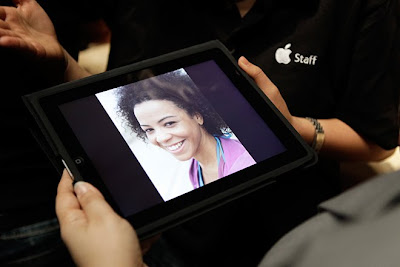
Apple iPad’s most striking feature, its gorgeous 9.7-inch touchscreen display, uses liquid crystal display technology — but with a few unusual twists — to present a vivid image and a wide viewing angle.
“The iPad’s display uses the same capacitive touchscreen technology as the iPhone and iPod Touch,” says Vinita Jakhanwal, principal analyst for iSuppli. “At the same time, it offers a better picture quality than conventional LCDs.”
After months of speculation, Apple launched its tablet, the iPad on Wednesday. The lightweight device (1.5 pounds) features a luminous touchscreen and a user interface similar to the iPhone. The iPad, which can cost $500 to $830 depending on the model, runs an expanded version of the operating system used in the iPhone.
Apple CEO Steve Jobs introduced the iPad’s screen as a LED-backlit with In-Plane Switching (IPS). Jobs was referring to a type of LCD screen that is more often found in HDTVs than it is in mobile devices.
So-called twisted nematic LCDs have dominated consumer laptop and phone displays. The viewing angle on these screens is limited, ranging from 110 to 120 degrees. When the screen is viewed outside this optimal range, its colors can look “off” and the overall image is faded or invisible.
In-Plane Switching helps fix those problems. In IPS LCD screens, the crystal molecules are oriented so their motion is parallel to the panel, instead of perpendicular to it. For viewers, the result is a very wide viewing angle — up to 180 degrees — with brilliant color.

“TVs have always used some variation of IPS in their LCD screens but now we are seeing this move to smaller computing devices,” says Jakhanwal.
The iPad’s screen, though, doesn’t have a wide aspect ratio, which is unusual in the TV-display world, says research firm DisplaySearch. Instead of a 16:10 or 16:9 aspect ratio, the iPad screen uses a 4:3 ratio.
“Perhaps they were trying to find a middle ground between the requirements for books, magazines and newspapers and the requirements for video and gaming,” say analysts at DisplaySearch.
The iPad display has some other interesting features. It is arsenic- and mecury-free and has a fingerprint-resistant oleophobic coating, which Apple had introduced in the iPhone 3G S. The iPad’s 1024 x 768 display resolution, at 132 pixels per inch, has chunkier pixels than the iPhone 3G S, which has a smaller display but a resolution of 163 pixels per inch.
But that may not be a fair comparison, says Jakhanwal. “If you have a smaller form factor, you need a higher resolution to better read the information on the display,” she says. Also, she adds, “the iPad has a more vivid display than a laptop screen.”
The iPad’s display is likely sourced from LG Display and Innolux, says iSuppli.
The biggest disappointment for tech enthusiasts is the lack of an OLED screen option in the iPad. That should be no surprise, say DisplaySearch and iSuppli. Display manufacturers just don’t have the fabrication capacity to create large quantities of big OLED displays, says Jakhanwal.
“The single supplier for active-matrix OLED screen today, Samsung Mobile, [its] current production capacity is all taken up by the mobile phone market,” she says. That means large volumes of very small screens.
“It’s unlikely they will scale back on that to produce lower volume, larger displays for Apple.”
Sony also produces OLED screens but in limited quantities, largely for its own products, like the Sony XEL-1.
Though Apple showed the iPad’s potential as an e-book reader, iSuppli and DisplaySearch remain skeptical about it. LCD screens, even in black-and-white mode, get washed out in bright sunlight. And if users turn on the backlight to improve the contrast, they are likely to draw down the device’s battery. On top of that, reading on an LCD means you’re staring into a light source, which produces more eyestrain than reading words by reflected light, as you do with printed pages or E Ink displays like those used in the Kindle, Nook and Sony Reader



No comments:
Post a Comment
Note: Only a member of this blog may post a comment.